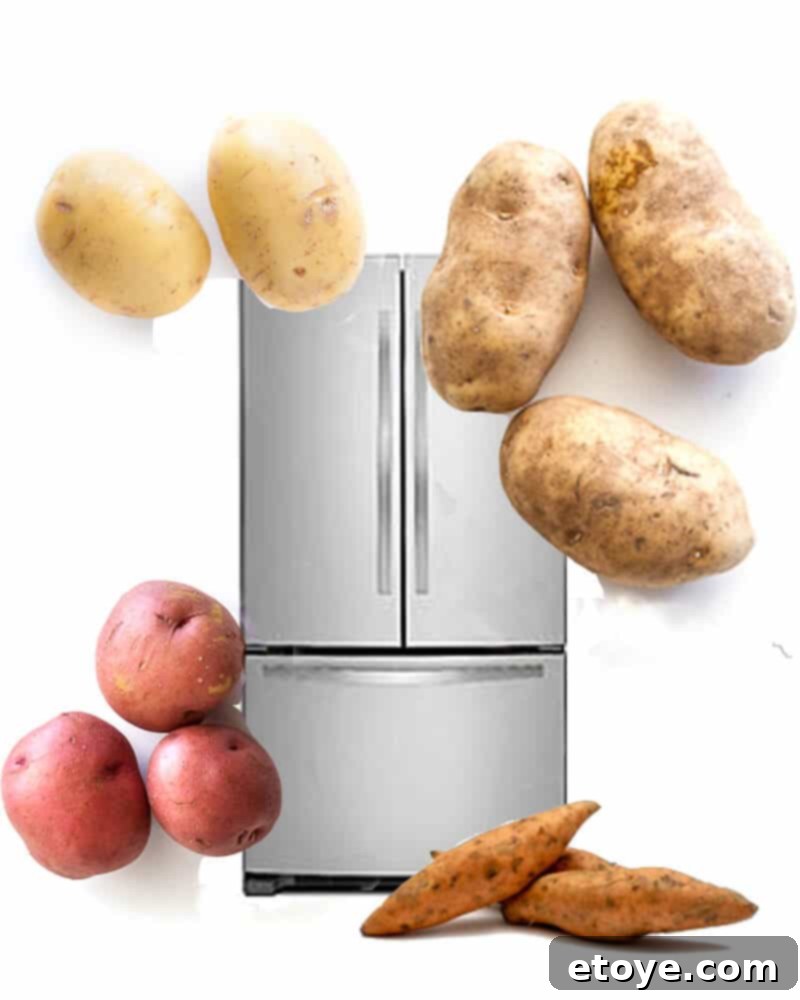Bringing home a fresh bag of potatoes often sparks a common question: what’s the ultimate way to store these versatile root vegetables? The answer, as it turns out, is more nuanced than simply tossing them into any available space. Proper potato storage is crucial not only for extending their shelf life but also for preserving their nutritional value, taste, and safety. Understanding the optimal conditions can prevent premature sprouting, greening, and the development of harmful toxins, ensuring your culinary creations always start with the best ingredients.
From kitchen counters to dark pantries, and even the controversial refrigerator, there’s a lot to uncover about keeping your potatoes in prime condition. This comprehensive guide will delve deep into the science and best practices for storing various types of potatoes, backed by expert recommendations. We’ll explore the ideal environments, common mistakes to avoid, and essential tips for identifying when a potato is past its prime. Get ready to unearth the secrets to perfect potato preservation, minimizing food waste and maximizing flavor in your home kitchen!
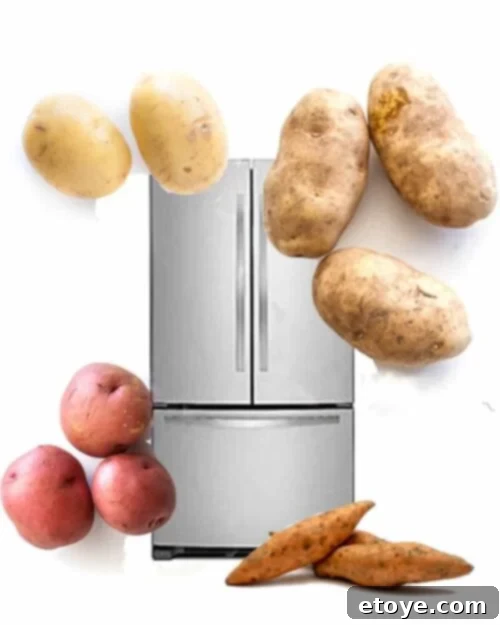
Optimal Potato Storage: Unearthing the Secrets to Freshness
For many home cooks, the journey of a potato begins at the grocery store and ends, ideally, as a delicious meal. But what happens in between, especially during storage, profoundly impacts its quality. The quest for the “best way to store potatoes” has led to extensive research by agricultural experts worldwide. We’ve compiled insights from leading institutions like the University of Idaho Extension and the Potato Research Centre, Agriculture and Agri-Food Canada, alongside other valuable resources, to provide you with definitive guidance on extending the shelf life of your spuds.
Our findings reveal a clear consensus: the key to long-lasting freshness lies in replicating the conditions of a cool, dark root cellar. The ideal environment for raw potatoes boasts high humidity and a consistent temperature range of 42°F to 55°F (approximately 5.5°C to 12.8°C). Think of a dedicated dark closet, a cool section of your garage, or a well-ventilated kitchen pantry as prime locations. These conditions are critical for several reasons: cooler temperatures slow down the metabolic processes that lead to sprouting and spoilage, while darkness prevents the formation of solanine, a natural toxin. Humidity is equally important, as it prevents the potatoes from drying out and shriveling, maintaining their firm texture.
To ensure your potatoes thrive in storage, consider these essential guidelines:
- DO keep potatoes in a breathable container: The perforated plastic bag they often come in is ideal, as it helps maintain humidity while allowing crucial air circulation. Alternatively, a mesh bag, a reusable produce bag, or even an open cardboard box can work wonders. Avoid airtight containers, which can trap moisture and accelerate spoilage.
- DO ensure they are stored in a DARK place: Light exposure, even ambient room light, can trigger the production of chlorophyll, leading to greening, and more importantly, the accumulation of solanine. If your storage area isn’t completely dark, draping the bag or container with a kitchen towel or placing them in an opaque bin can provide the necessary protection.
- DO NOT store potatoes where it’s warm: High temperatures significantly accelerate sprouting and spoilage. Avoid areas like under the sink (often warm and damp), near heat-emitting appliances (refrigerators, ovens, dishwashers), or in direct sunlight. Heat promotes rapid respiration and sugar conversion, compromising texture and taste.
- DO NOT wash potatoes until ready to use: The dirt on potato skins acts as a natural protective barrier. Washing them prematurely removes this barrier, introduces moisture, and creates an ideal environment for bacterial growth and mold, drastically reducing their shelf life. Brush off any excess dirt gently before storage, but save the thorough wash for right before cooking.
- DO ensure good air circulation: Piling potatoes too high or storing them in sealed containers can lead to poor air circulation, trapping moisture and ethylene gas, which can accelerate sprouting and decay. Allow for ample space around your potato storage to facilitate airflow.
By diligently following these principles, you can significantly extend the freshness of your potatoes, often keeping them viable for several weeks, or even months, depending on the variety and initial condition.
To Refrigerate or Not to Refrigerate? A Deep Dive into Potato Chilling

The question of whether to refrigerate potatoes is one of the most debated topics in kitchen storage. While traditional advice often warns against it, there are specific scenarios and considerations that warrant a closer look. The Food Standards Agency (FSA) and other food safety bodies have historically advised against refrigerating raw potatoes due to concerns about increased acrylamide formation when potatoes stored at low temperatures are subsequently fried or roasted at high temperatures. Acrylamide is a chemical compound that can form in starchy foods during high-temperature cooking processes (above 248°F or 120°C).
However, recent research and evolving understanding suggest a more nuanced approach. If your home environment is consistently too warm – for instance, during hot summer months, or if you lack a naturally cool pantry or basement – refrigeration can be a viable short-term solution to prevent rapid sprouting and inhibit the growth of certain potato disease-causing organisms that thrive in higher temperatures. In such cases, the benefits of preventing spoilage might outweigh the acrylamide risk for some cooking methods.
The primary effect of refrigerating potatoes is the conversion of starch into sugar, a process known as “cold-induced sweetening.” This can result in a slightly sweeter potato, which might be desirable for some dishes. However, this increased sugar content also leads to quicker browning and darkening when the potatoes are fried in oil, such as for french fries or potato chips. This darkening is due to the Maillard reaction, which is accelerated by higher sugar levels and can also contribute to increased acrylamide formation.
Considering these factors, here’s a refined guide on refrigerating potatoes:
- You CAN refrigerate potatoes if your home is too warm: If maintaining the ideal temperature range of 42-55°F is impossible due to ambient room temperatures, especially during warm seasons, the refrigerator can offer a temporary reprieve. This will significantly slow down sprouting and bacterial growth, preserving the potato’s firmness for a longer period than if left in a warm environment.
- DO NOT refrigerate potatoes if you are planning to fry them in oil: Due to the starch-to-sugar conversion, refrigerated potatoes will brown much faster and turn darker when fried, potentially affecting their appearance and flavor, and increasing acrylamide levels.
- Refrigeration is perfectly fine for other cooking methods: If you are boiling, steaming, baking, roasting, or mashing potatoes, refrigeration will not negatively impact their texture or safety in the same way frying does. The slightly sweeter taste might even be preferred in some recipes.
- DO keep potatoes in the plastic bag they come in when refrigerating: This helps to maintain humidity and prevent them from drying out in the low-humidity environment of a refrigerator. However, ensure the bag has small perforations for some air exchange.
Ultimately, the decision to refrigerate depends on your specific circumstances, available storage options, and intended cooking method. Prioritizing a cool, dark, and humid environment outside the fridge remains the gold standard, but refrigeration can serve as a practical alternative when those conditions cannot be met, especially for non-fried applications.
The Unfriendly Neighbors: Why Potatoes Should Avoid Onions and Fruit
 One of the most common storage mistakes is keeping potatoes alongside certain other fruits and vegetables, particularly onions and apples. This seemingly innocuous practice can dramatically shorten the shelf life of your potatoes due to the release of ethylene gas.
One of the most common storage mistakes is keeping potatoes alongside certain other fruits and vegetables, particularly onions and apples. This seemingly innocuous practice can dramatically shorten the shelf life of your potatoes due to the release of ethylene gas.
Ethylene is a natural plant hormone that acts as a ripening agent. Many fruits, such as apples, bananas, and pears, are prolific producers of ethylene. While beneficial for ripening certain produce, it can be detrimental to others, including potatoes, by accelerating their aging process. When potatoes are exposed to ethylene, their respiration rate increases, prompting them to sprout faster and deteriorate more quickly. Even a short exposure to ethylene-producing produce can significantly increase the rate of sprouting in potatoes.
While some research on the direct interaction between onions and potatoes regarding ethylene release can appear conflicting, the general consensus and most comprehensive controlled studies strongly advise against storing them together. Onions, particularly as they age or if bruised, can release some ethylene. More importantly, they also release moisture and strong odors that can be absorbed by potatoes, affecting their flavor and potentially encouraging spoilage.
Therefore, to safeguard your potato supply and maximize their freshness:
- DO NOT store potatoes and onions together: Maintain a clear separation. Store onions in a cool, dry, well-ventilated area, preferably away from potatoes, in a mesh bag or open container.
- DO NOT store potatoes and fruit together: Especially keep potatoes away from ethylene-emitting fruits like apples, bananas, and ripening tomatoes. Store these fruits in their appropriate locations, far from your potato stash.
By simply providing potatoes with their own designated storage space, away from these ethylene-producing companions, you can make a significant difference in their longevity and quality.
Sweet Potato Storage: A Different Set of Rules

While often grouped with regular potatoes due to their root vegetable status, sweet potatoes demand a distinct storage approach. They are not true potatoes and have different needs when it comes to temperature and humidity. Unlike their starchy cousins, sweet potatoes prefer slightly warmer temperatures and higher humidity levels to maintain their quality and flavor.
The ideal conditions for storing sweet potatoes are temperatures between 55°F and 60°F (12.8°C to 15.6°C) with approximately 80% humidity. These conditions are often found in a cool, dark pantry or a dry basement, rather than the colder environment preferred by regular potatoes. Before storing, ensure your sweet potatoes are unwashed. The skin acts as a protective barrier, and introducing moisture can promote mold and rot.
For optimal storage, place them in a large brown paper bag, a perforated plastic bag, or an open cardboard box. This allows for adequate air circulation while providing the necessary darkness. When stored correctly, especially if they have been properly cured (a process often done by growers to heal cuts and toughen skins), sweet potatoes can remain fresh for an impressive duration, often up to 6 months.
A critical rule for sweet potato storage is regarding refrigeration:
- DO NOT refrigerate sweet potatoes: Exposing sweet potatoes to cold temperatures, especially below 50°F (10°C), causes internal damage. This can lead to a hard, woody center, an unpleasant texture, and an altered flavor profile that diminishes their natural sweetness. The cold can also cause them to spoil more quickly. Always keep them at room temperature or slightly cooler, away from the chill of the refrigerator.
By understanding and respecting these unique storage requirements, you can enjoy your sweet potatoes at their peak quality for an extended period.
Navigating Potato Imperfections: When is a Spud Still Good?
Even with the best storage practices, potatoes can sometimes develop visual imperfections. Knowing which ones are harmless and which signal a health risk is crucial for food safety and minimizing waste.
Is Green on Potato Safe to Eat?

Potatoes turn green due to the accumulation of chlorophyll, a natural plant pigment, when exposed to too much light or sunlight. While chlorophyll itself is harmless, its presence often indicates a parallel increase in a more concerning chemical compound called solanine. Solanine is a glycoalkaloid that develops as a natural defense mechanism in potatoes when they are stressed or exposed to light. It tastes bitter and, in large quantities, can be toxic, causing symptoms ranging from stomach upset and nausea to more severe neurological effects. Solanine is the plant’s way of deterring pests and animals from eating uncovered tubers during growth.
- DO slice off any green spots: If the green areas are limited to small, shallow patches on the surface of your potato skins, you can safely trim them away with a peeler or knife before cooking. Be generous with your cut to ensure all green tissue is removed.
- DO NOT eat the potato if the green areas cover most of it or penetrate deeply: If a significant portion of the potato has turned green, or if the greening extends beyond the skin into the flesh, it’s best to discard the entire potato. In such cases, the solanine concentration is likely too high to be safely consumed, even after cooking, as cooking does not significantly reduce solanine levels.
Preventing greening is simple: store potatoes in a completely dark place. Regular inspection of your stored potatoes can also help catch early signs of greening before it becomes extensive.
(Image source: all-about-potatoes.com)
Are Sprouted Potatoes Safe to Eat?
Sprouts are a natural sign that a potato is attempting to grow. While a few small sprouts don’t necessarily mean the potato is inedible, they do indicate that the potato is aging and its nutritional content might be diminishing. Sprouts, like green skin, can contain elevated levels of solanine.
- DO cut off sprouted parts if the potato is still firm: If your potato has just a couple of small sprouts “peeking through” but the potato itself remains firm and healthy-looking, you can safely cut off the sprouts along with about half an inch of surrounding flesh. Then, cook and enjoy as usual.
- DO NOT eat if the potato is soft and wrinkly with extensive sprouts: A potato that is soft, shriveled, or has numerous long, significant sprouts is past its prime. In this state, the potato has likely lost much of its moisture and nutrients, and the solanine content may be higher throughout the entire potato, not just in the sprouts. For safety and quality, it’s best to discard such potatoes.
Proper storage in a cool, dark environment will significantly slow down the sprouting process, giving you more time to enjoy your potatoes.
What is the Black Crusty Dirt on the Potato?

If you’ve ever noticed stubborn black spots on your potatoes that resemble caked-on dirt, particularly around the “eyes” or on the skin surface, you’ve likely encountered “Black Scurf.” This isn’t dirt at all, but rather a common potato disease caused by the fungus Rhizoctonia solani. These black spots are known as sclerotia – compact masses of fungal mycelium that are dormant and cling tightly to the potato skin.
Despite its unappealing appearance, Black Scurf is generally considered harmless to consume. It primarily affects the cosmetic quality of the potato and does not typically penetrate the flesh deeply enough to pose a health risk. It’s often found on potatoes grown in cooler, wetter soils.
- DO try to scrub or cut off as much of it as you can: While safe to eat, the texture of the black scurf can be gritty or unpleasant. A good scrub brush or a vegetable peeler can effectively remove most of these unsightly spots. If they are particularly stubborn or deep, simply cut them away before cooking.
(Image source: potatoes.ahdb.org.uk)
What is the Hole in the Middle of the Potato?
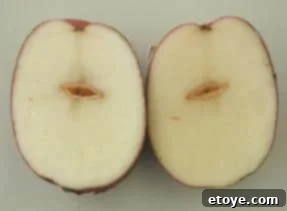
Discovering a hollow space, sometimes discolored with black or brown edges, inside a potato can be alarming. It might look like rot or damage from an insect. However, this phenomenon, known as “hollow heart,” is an internal physiological disorder, not a sign of spoilage or pest infestation.
Hollow heart is primarily caused by environmental stresses during the potato’s growing season. These stresses can include rapid changes in weather conditions, such as sudden shifts from dry to excessively wet periods, or inconsistent nutrient availability. When growth rates fluctuate too quickly, the inner tissues of the potato can fail to develop properly, creating a void or cavity. While unsightly, hollow heart does not affect the safety or flavor of the surrounding potato flesh.
- DO just cut the hole or discoloration away: The affected area is perfectly safe to eat once the hollow or discolored parts are removed. Simply cut out the cavity and any surrounding discolored tissue before preparing your potato.
(Image source: inspection.gc.ca)
The Definitive Guide to Identifying Spoiled Potatoes
Understanding when a potato has gone bad is as critical as knowing how to store it correctly. Consuming spoiled produce can lead to uncomfortable, or even serious, health issues. By familiarizing yourself with the signs of spoilage, you can confidently ensure that only the freshest and safest potatoes make it to your plate.
Clear Signs of Spoilage in Potatoes:
- Soft Spots and Wrinkles: A healthy, fresh potato should feel firm and solid. If your potato develops soft spots, feels mushy, or its skin begins to wrinkle and shrivel, these are clear indicators that it’s losing moisture and freshness, signifying it’s past its prime.
- Foul Odor: A good potato has an earthy, neutral, and somewhat clean scent. If you detect any unpleasant smell—musty, moldy, sweet, or distinctly rotten—it’s a strong sign that the potato has begun to decompose. This odor is often accompanied by the release of liquid.
- Extensive Green Tinges: While small green areas can be trimmed, if a potato has significant greening that covers a large surface area or penetrates deep into the flesh, it suggests a high concentration of solanine. This toxin can cause digestive distress and is best avoided by discarding the potato.
- Prolific Sprouting: A few small sprouts can be removed. However, if sprouts are long, numerous, or accompanied by a generally soft, shriveled potato, it indicates that the potato has been aging rapidly and its internal quality has deteriorated. The potato’s nutrients are being used for growth, and toxin levels may be elevated.
- Visible Mold Growth: Any visible mold, typically fuzzy green, black, or white patches on the skin, means the potato is spoiled. Mold spores can penetrate deeper than they appear on the surface, making the entire potato unsafe to eat, even if you cut off the visible mold.
The Warning of a Bitter Taste:
- Tasting Bitter? Discard Immediately: Sometimes, a potato might look outwardly acceptable but taste distinctly bitter when cooked. This bitterness is a tell-tale sign of elevated solanine levels, which can occur due to age, improper storage, or stress during growth. Never attempt to eat potatoes that taste bitter; it’s a direct signal of potential toxicity and a serious health risk.
The Consequences of Consuming Rotten Potatoes:
- Risks of Food Poisoning: Eating potatoes that exhibit signs of spoilage, especially those with high solanine levels or mold, can lead to food poisoning. Symptoms can range from mild gastrointestinal upset (nausea, vomiting, diarrhea) to more severe conditions like headaches, fever, and neurological issues.
- When in Doubt, Throw It Out: This simple adage is the safest rule for any questionable food item, especially potatoes. The potential health risks associated with spoiled potatoes far outweigh the cost of discarding them. Prioritizing your health and well-being should always come first.
By diligently monitoring your potato supply for these clear signs of spoilage, you can confidently ensure that every potato you cook is fresh, safe, and delicious, enhancing your culinary experience and safeguarding your health.
References:
Oxford Journals Research: Factors Affecting Potato Sprouting
University of Idaho Extension: Options for Storing Potatoes at Home
Plant Physiology: Effects of Ethylene on Potatoes
University of Idaho: About Potatoes FAQ
Vegetable MD Online: Black Scurf (Rhizoctonia) on Potatoes
University of Florida Extension: Hollow Heart in Potatoes
North Carolina Sweet Potato Commission: Curing and Storing Sweet Potatoes
Enhance Your Kitchen with Favorite Potato Tools
Having the right tools can make all the difference in preparing potatoes, from simple peeling to crafting gourmet dishes. Here are some of my top recommendations for essential potato tools that combine efficiency, durability, and ease of use.
For effortless peeling, the Oxo brand peeler set is a consistently reliable choice. Known for their comfortable grips and sharp blades, Oxo peelers make quick work of even the most stubborn potato skins. This set of three offers excellent value, often costing about the same as a single peeler from other brands. Another great option is the lightweight Kuhn Rikon peeler. Its incredibly sharp carbon steel blade glides through skins, but be aware that it requires immediate handwashing and drying to prevent rust, as it’s not stainless steel.
When it comes to creating mashed potatoes, the texture you desire dictates the tool you’ll need. For a more traditional, slightly chunky mashed potato – perfect for leaving some skin on for added texture and nutrients – an ergonomic mashing tool is essential. The Oxo Good Grips Potato Masher with its sturdy head and comfortable non-slip handle is a personal favorite. Avoid mashers with flimsy designs or awkward angles, as they can be frustrating to use and clean.
If you’re aiming for irresistibly smooth and creamy mashed potatoes, a potato ricer is your best friend. A good ricer effortlessly transforms cooked potatoes into fine, fluffy strands, eliminating lumps for an unparalleled texture. My initial experience with a basic ricer was disappointing – it was hard to use and a nightmare to clean. However, a recommendation from Cooks Illustrated led me to the RSVP Stainless Steel Potato Ricer. This model is a game-changer; it’s easy on the hands, simple to operate, and incredibly easy to clean, thanks to its interchangeable and removable plates for both coarse and fine ricing. It’s the secret weapon for recipes like my Very Best Mashed Potatoes, a simple two-ingredient technique learned from a professional chef.
Whether you’re peeling, mashing, or ricing, investing in quality potato tools will elevate your cooking experience and help you achieve perfect results every time.
- OXO Good Grips 3-piece Everyday Peeler Set
- Kuhn Rikon Original Swiss Peeler
- OXO Good Grips Stainless Steel Masher with Soft Handle
- RSVP International Stainless Steel Potato Ricer
- Norpro Commercial Potato Ricer (mentioned as not recommended in original, but keeping link as context for contrast)
My Favorite Potato Recipes to Inspire Your Cooking
Potatoes are incredibly versatile, forming the foundation for countless delicious dishes. From simple roasted sides to comforting mashed creations and vibrant salads, there’s a potato recipe for every occasion. Here are some of my go-to recipes that highlight the incredible potential of this humble vegetable:
Perfectly Roasted New Potatoes
New potatoes, with their delicate skin and creamy texture, are best enjoyed simply roasted to let their natural flavors shine. This method brings out a lovely caramelization and a tender interior.
Preheat your oven to a robust 450°F (232°C). If you have new potatoes larger than 2 inches in diameter, cut them in half to ensure they cook evenly. On a large baking sheet, toss the potatoes with a generous drizzle of good quality olive oil. Spread them in a single layer, ensuring they’re not overcrowded, which can lead to steaming rather than roasting. Roast for 30-40 minutes, checking for tenderness and golden-brown edges – cooking time will vary slightly depending on the size of your potatoes. Once done, season generously with sea salt and freshly ground black pepper.
For a more aromatic twist, prepare garlicky new potatoes. In a large bowl, combine a couple of cloves of finely minced garlic (a garlic press works best here for maximum flavor extraction), olive oil, and fresh minced rosemary or thyme. Fresh herbs are crucial for this dish; dried herbs simply won’t yield the same vibrant taste. Toss the potatoes thoroughly with this fragrant mixture using your hands until every potato is beautifully coated. Then, proceed with roasting as described above. Season with salt only after the potatoes are out of the oven to prevent them from drying out.
Potato Dominoes Recipe
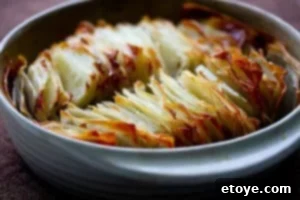
Very Best Mashed Potatoes — just 2 ingredients!
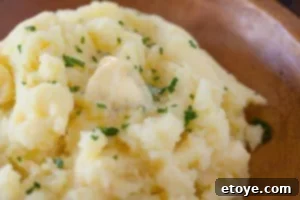
Warm Asian Roasted Potato Salad with Sesame-Chili Dressing

Miso Mashed Potatoes
Broccoli Potato Bacon Hash
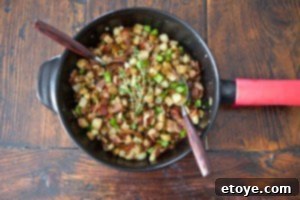
More Delicious Potato Recipes to Explore
If you’re looking for even more ways to enjoy potatoes, these fantastic recipes from other culinary experts offer diverse flavors and cooking techniques:
- Herbed New Potatoes – Food & Wine
- Garlic and Cumin New Potatoes – Betty Crocker
- Butter Steamed New Potatoes – Deep South Dish
- Crash Hot Potatoes – The Pioneer Woman
